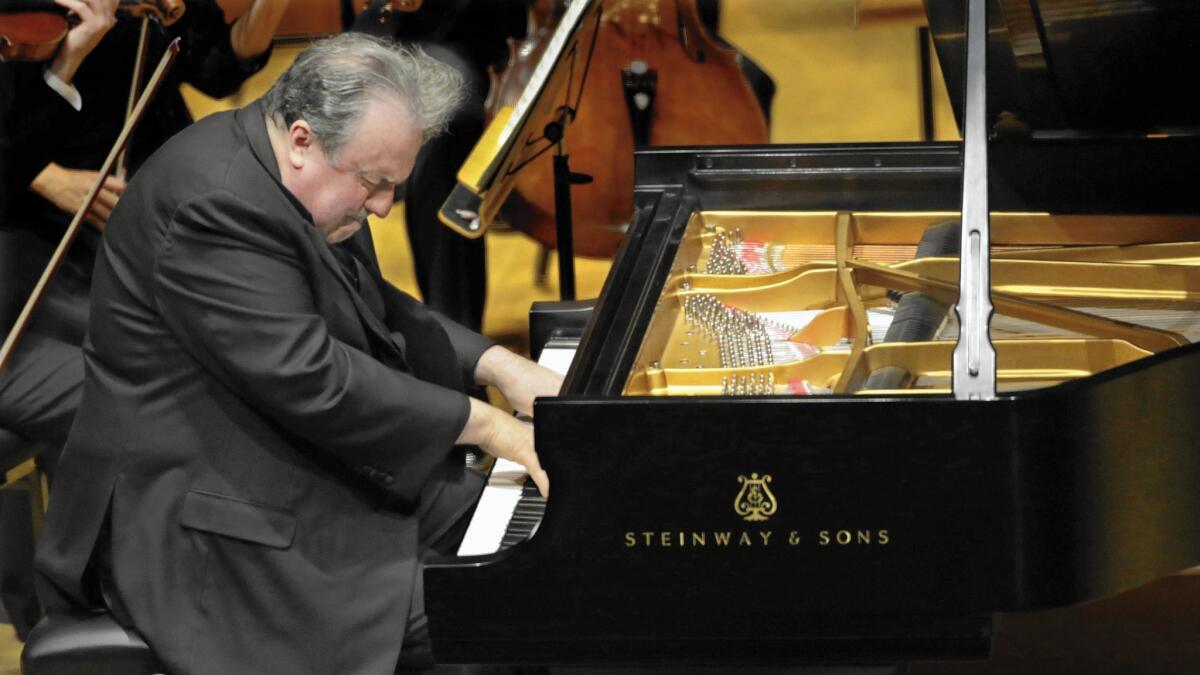Review: Bach and Brahms, still revolutionary

- Share via
The Los Angeles Philharmonic has long been the model of a progressive orchestra.
But while its management and board were at a retreat to brainstorm about innovation Thursday, the orchestra’s adventurous young music director began a diverse series of May concerts at Walt Disney Concert Hall with a Brahms and Bach program confidently rooted in the past and one that drew a large, enthusiastic crowd.
Gustavo Dudamel, in fact, focused on two composers who, in their lifetimes or just after, represented reactionary musical thinking. Bach brought the Baroque to its climax, and once he died in 1750, music was ready to move on from complex, academic counterpoint to a lively new simplicity that would eventually make the Classical era of Haydn and Mozart possible.
A century later, Brahms looked back to Bach as a model and in opposition to his nemesis Wagner, who signified music of the future.
Innovation is never, however, that simple. Revolutions with lasting effects build upon substantive ideas that have weathered the test of time. And Dudamel — who will be paying plenty of attention to today’s composers who also heralded a movement for a revolutionary new simplicity in the Next on Grand festival later this month — did a vivid job of providing musical perspective to the whole concept of progressivism.
We now find inherent in Brahms and Bach other roots that led to some of the greatest musical innovations. After having created the 12-tone system in the early 20th century that changed music forever, Schoenberg near the end of his life in Los Angeles wrote about the debt he owed to Bach, whom he called the first composer of 12-tone music, and Brahms, whom he considered a crucial progressive who taught him how to say something in music directly “without so much sentimental fuss.”
The first half Thursday was Brahms.
Yefim Bronfman was soloist in the big, symphonic Piano Concerto No. 1 in D Minor. Written when Brahms was in his early 20s, the concerto was a radical effort to merge newness with tradition. Themes transform almost as actively as with Wagner. But Brahms also looks back at Bach with a formal fugue in the Finale.
Dudamel’s Brahms is broad and grand if not as measured as it was for his “Brahms Unbound” four years ago. What is new is an increasing attention to inner voice complexities, to teaming syncopations and dissonant counterpoint that gives the score its life.
Bronfman remains his impressively granitic self at keyboard. His attacks are ever sharp and startling. He can erupt like no one else, and he did more than once. But he can scale down to gleaming delicacy, and he did that too, sublimely, in the slow movement.
Then there are Bronfman’s torrents of fiery virtuosic ferocity that he unleashed in the last movement.
This was Brahms, then, not as one thing, and after intermission came multiple Bachs. The modern interest in Bach began in the 20th century, and Dudamel offered two extremes of that interest.
He began the second half with Anton Webern’s severe, pointillist, finely colored orchestration of the six-voice fugue from “The Musical Offering.” He ended the concert with Leopold Stokowski’s flamboyant orchestration of the D-Minor Toccata and Fugue for a massive orchestra. In between came the Orchestral Suite No. 3 in D.
Webern’s transcription breaks up single melodic lines between different instruments, modernizing Bach not by changing notes or rhythms but with sonic juxtapositions of instrumental colors. Dudamel’s approach was less jarring and more elusive than most, blending shades to emphasize the continuity of line.
In the suite, which includes the famous “Air on a G String,” Dudamel toyed with a period practice approach, which included ornamentations and quirky accents and worked very well. The strings applied little vibrato. Joanne Pearce Martin played a harpsichord (audible mainly in the air) and Joseph Pereira used small period timpani. The L.A. Phil brass were not, however, brittle like brass of yore but commanded an assured tone.
The Stokowski followed with a big Bach bath. This is the Dudamel that audiences love, embracing the full possibility of 100-plus musicians in a spectacular Technicolor fantasia. It happens to be, in its own way, as brilliantly inventive an orchestration as Webern’s, and the L.A. Phil sounded spectacular.
I think it is safe to say Brahms would not have approved (he might not have liked Schoenberg either). But I wonder about Bach, who was always refashioning things and was not quite as stern as Brahms.
Still, Brahms passed Bach on to Schoenberg, Webern, Stravinsky and, yes, the Hollywood-flashy Stokowski.
It was a night of Brahms and Bach, mainly in the key of D, which here stood for Dudamel and also, intriguingly, for the acknowledgment that real innovation has its basis in development.
Dudamel conducts Bach and Brahms, Walt Disney Concert Hall, 111 S. Grand Ave., Los Angeles, 8 p.m. Saturday and 2 p.m. Sunday, $26.50-$212, (323) 850-2000 or https://www.laphil.org
More to Read
The biggest entertainment stories
Get our big stories about Hollywood, film, television, music, arts, culture and more right in your inbox as soon as they publish.
You may occasionally receive promotional content from the Los Angeles Times.











